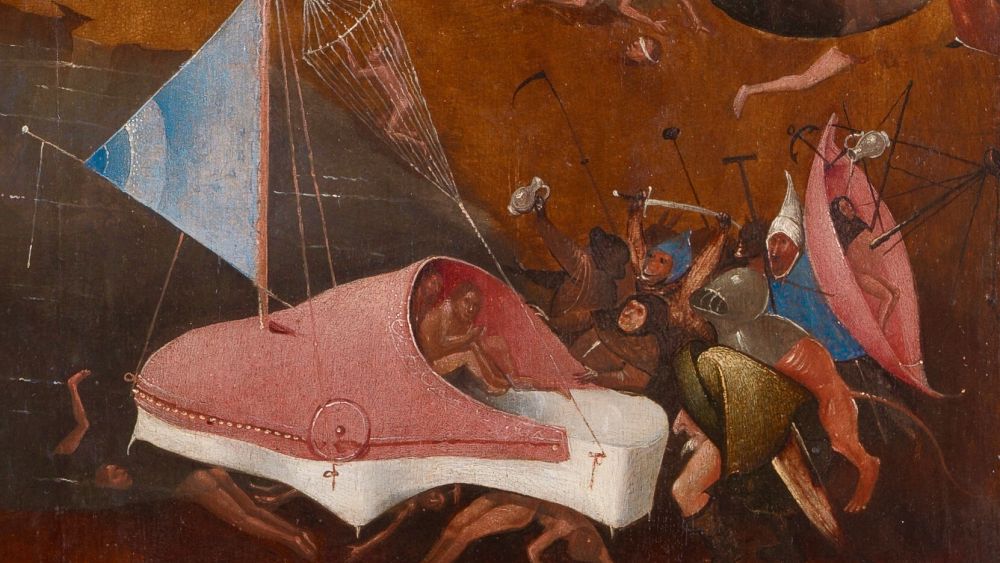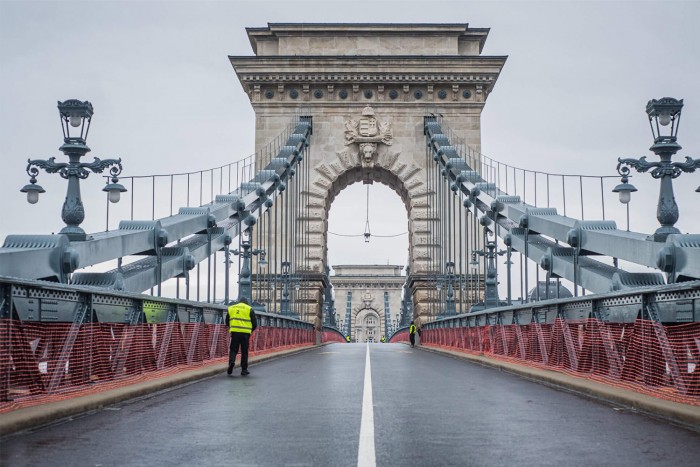7 + 1 interesting facts about the Bosch exhibition in Budapest
It is a world sensation that the Museum of Fine Arts has organized a comprehensive exhibition of Bosch’s works, as the museums that preserve the works only allow priceless works to be exhibited abroad. We can now admire ten original Bosch paintings in Budapest, which is half of the master’s surviving oeuvre.
# 1 Deciphered and still mysterious details
One of Bosch’s best-known paintings is the Ship of Fools, which the Museum of Fine Arts has managed to acquire from the permanent collection of the Louvre for the exhibition in Budapest.
This work is one of the best examples of the fact that researchers have not been able to decipher the full symbolism of the master’s works even after five hundred years, the meaning of many details is revealed, while several motifs remain mysterious.
The drifting ship is a symbol of the uncertainty of human existence. Looking at the picture, it is also clear that the drunken company is drifting into its loss. The owl sitting on the tree that serves as the mast of the ship also points to the danger and, in a figurative sense, to the ominous darkness that oppresses humanity. László Baán, the director general of the Museum of Fine Arts, explained when unpacking the painting that while in ancient Roman culture the owl was a symbol of reason, a bird of light, in Bosch’s time it was a symbol of darkness.
The danger is also indicated by the crescent flag on the mast of the ship, the horror of Islamic conquests kept Europe in fear. It is also easy to interpret the figure of a fool sitting on a branch of a tree, as the horns on his head and the mocking right in his hand, the talking stick, are common hallmarks.
However, the figure of a nun and a priest on either side of a hanging pie is mysterious. It is not known whether in the drunken company they want to bite into the pie or sing while snarling at the squirrels. Art historians also suspect that their presence may suggest that Bosch’s critique of society applies not only to secular people but also to the clergy.
# 2 What did people say then?
Most of Bosch’s works are not as public in life as they are today. His secular triptychs evoke medieval swinging altars with their three plaques, but non-ecclesiastical commissioned works have not come close to the average person attending church.
A small circle of people who ordered and owned the pictures were happy with the works. It was the attraction of a hedonistic social event or feast that opened the wings protecting and hiding the middle panel.
It is doubtful, for example, whether Albrecht Dürer could have seen the legendary work, the Garden of the Beauties of the Earth, when he was introduced in 1520 to III. In the palace of Henry of Nassau in Brussels. Researchers are likely to have opened the triptych only on rare occasions, and Dürer did not see the masterpieces. When closed, the outside of the boards is visible, which is less spectacularly painted than the inside.
# 3 Would humanity’s path from the Garden of Eden really lead to hell?
For most of us, yes, those who see the path in Bosch’s creations as almost linear claim. Already in the Garden of Eden, Bosh, for example, displays the original sin on the left panel of the Garden of Earthly Beauties.
In the tapestry made on the basis of the creation, the idyllic states are broken by one of the central figures, the figure of a charming panther, who carries his prey in his mouth, symbolizing that the creatures of the Garden of Eden have broken against each other. Thus, it is as if we were doomed from the beginning to choose not the right but the wrong way to go to hell instead of heaven in the challenges of earthly existence.
# 4 Who is the man in the hat?
According to legend, Hieronymus Bosch himself is the hat face in the scene of hell on the Garden Tapestry of the Beautiful. But it was not only this detail that was highlighted by Munoz Martin Roberto, the curator accompanying the work to Budapest.
An expert from the Royal Collection of Madrid also draws attention to the letters on the two lower corners of the tapestry, the logo of the Brussels tapestry weavers and the monogram of the creators. The work of their hands made the tapestry more valuable than the original painting. Gold and silver fibers were used for the richness of the workmanship, and the silk yarns were dyed separately to a color that restored Bosch’s image by weaving them into textiles.
# 5 Budapest special station
The tapestry created by Bosch has rarely traveled since World War II. It was once borrowed for an American exhibition, then for the anniversary exhibition in Rotterdam, Budapest is the third venue where we can admire it.
The Prado never borrows the original triptych, so the organizational feat also managed to get the wall cover, which is also five hundred years old, and an early copy of one of Bosch’s first followers. The unknown artist confidently used Bosch’s technique, but we also discover his own style.
# 6 Bravely against stupidity
Bosch hid a wealth of symbols and references to his richly painted works, giving his audience the opportunity for associations. His work Stone Operation was still easy to understand five hundred years ago, but the man of today must know an old saying.
According to a Dutch proverb, whoever is a fool carries the stone in his head. In Bosch’s picture, therefore, the operation is not medical, but figurative. Its purpose is to free the patient from stupidity. Bosch shows his arrogance, almost impudence, that he intended his painting for the noble circles.
# 7 Bosch fever in the artefacts market is unbroken for half a millennium
Bosch’s unique visual language dates back to the 16th century. century, it was so esteemed that a real Bosch fever broke out in the artefacts market.
His followers not only used but also dampened demand. Some made exact copies, others made imitations in the spirit of Bosch. Among them are many works of a quality that is extremely valuable for posterity, and the exhibition in Budapest presents such pieces. Bosch’s unbroken cult to this day is due not only to his own talent but also to the diligence of his followers.
+1 Bosch’s biggest secret is still a mystery
The biggest, and therefore the most interesting, challenge for researchers is to figure out what inspired Hieronymus Bosch to create his unique treasure of form.
According to the most accepted view, humorous drawings were made in several religious-themed codes, manuscripts, and prehistoric forms to counterbalance the serious content. In these illuminated books, we find strange yet ordinary figures, specially drawn creatures, that may have inspired Bosch.
The figures, which carry humor, social judgment or other moral content, are sometimes illusory figures in Bosch’s works, other times very ordinary people, almost reminiscent of the life pictures of Dutch painters, reminiscent of ordinary naturalism.
Bosch lived for a long time in a house overlooking the market square in Hertogenbosch, the Netherlands. It was enough to look out the window to see all sorts of people, from the stuntmen to the half-crazy, he was aware of the fate of the wanderers looted in the public houses or the locals roaming there as well. Millions of everyday mosaics can be found in his works to put the details into moral meaning.
The Last Judgment is mentioned as one of his best-known works. On the middle board of the triptych we see the Savior Christ as the Judge. Behind the barge leading to the afterlife, the brightness of Heaven shines in the upper left corner, but the horizon is dominated to a greater extent by the dreaded darkness that leads to hell.
The sign on the right is devoted entirely to hell by the artist, richly depicting the enduring suffering and eternity of eternity to remind the viewer even during his earthly life: we are always in a decision-making position until the moment we die, it is never too late to choose the right path.
Between heaven and hell. The mysterious world of Hieronymus Bosch
Museum of Fine Arts, Budapest, April 9, 2022 – July 17, 2022




